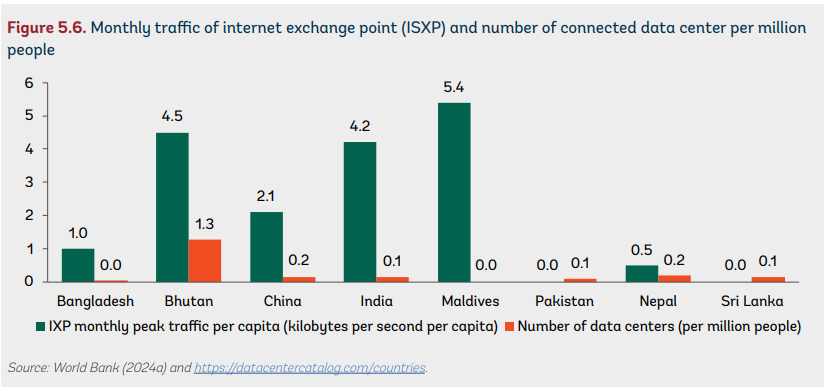Although Nepal’s digital sector is smaller than those of other South Asian countries, it has demonstrated potential for economic growth and job creation. A World Bank report highlights that Nepal’s exports of digitally provided services grew by 12.3 percent annually from 2005 to 2023.
Nepal’s information and communication technology (ICT) sector has made notable progress in the region, particularly in employment generation. In 2022, ICT services accounted for 1.7 percent of Nepal’s GDP—higher than any other South Asian country except India. Between 2012 and 2024, the sector contributed 0.3 percent to Nepal’s real GDP growth per year. According to 2023 data from the Federation of Nepalese Chambers of Commerce and Industry (FNCCI) and the International Finance Corporation (IFC), the private sector contributed 80 percent of the sector’s total value.
Despite this progress, digital adoption remains low. As of 2023, 48 percent of businesses in Nepal did not have their own website. Digital transactions were also limited, with only 9.6 percent of payments and 23.3 percent of customer sales occurring through digital channels.

Challenges in Digital Infrastructure
Investment in digital infrastructure remains insufficient. In 2019, only 1.1 percent of Nepal’s total capital was allocated to ICT. Several factors hinder digital transformation, including high internet costs, frequent network issues, limited internet access in rural areas, and a lack of digital skills.
As of 2021, only 37.8 percent of Nepali households had internet access, and computer usage stood at just 15 percent. While more than 90 percent of firms in Nepal use fixed broadband, only half of them have a website. However, website usage among small industries has risen by 47.2 percent, with slightly higher adoption in the service sector.
Nepal’s mobile network expansion has been significant, covering 90 percent of the population with 3G and 88 percent with 4G. However, 5G coverage remains minimal at just 5 percent. In terms of internet download speeds, Nepal lags behind other countries in the region.

Internet Bandwidth and Fiber-Optic Expansion
Nepal relies on India and China for internet bandwidth, spending Rs 4.7 billion on bandwidth imports in 2023. Around 50 percent of the population lives at least 10 kilometers away from a fiber-optic network. To address this gap, the government plans to lay 6,300 kilometers of fiber-optic cables through the Rural Telecommunication Development Fund (RTDF).
Steps Needed for Digital Transformation
The report points out to the need for the government to accelerate digital adoption to boost IT exports and job creation. The report emphasize the need for digital identification (Digital ID), promotion of digital signatures, and investment in high-tech infrastructure. If implemented effectively, digital technology could significantly drive Nepal’s economic growth and employment, say experts.
In terms of data infrastructure, the Nepal Internet Exchange (NIXP) has helped reduce data costs. Nepal currently has six data centers that support cloud services, but their number remains inadequate. On the digital public infrastructure front, initiatives such as the National ID, Nagarik App, and Connect IPS have expanded digital access. The World Bank report notes that the Nagarik App has 800,000 users, while Connect IPS has 380,000 users.
Experts suggest that to accelerate Nepal’s digital transformation, the government should expand digital infrastructure, introduce regulatory reforms, restructure the RTDF, scale up the Digital Ship Program, and ensure affordable access to digital devices. Although the government has launched economic incentive programs to attract private sector investment in ICT, significant challenges remain in harnessing the full potential of digital technology.

ICT Jobs: Skills Shortage
Employment in Nepal's ICT sector grew at an annual rate of 5.1 percent from 2011 to 2021, reaching 52,145 workers. However, despite this growth, the sector still accounts for only 0.35 percent of the country's total workforce, highlighting its relatively small presence in the labor market.
The availability of ICT and STEM (Science, Technology, Engineering, and Mathematics) skills remains low in Nepal. Among individuals with a medium level of education, only 0.16 percent possess ICT or STEM-related skills, while the proportion among highly educated individuals stands at just 2 percent. This limited pool of skilled professionals poses a challenge to the sector's expansion.
A significant factor contributing to the skills shortage is the limited availability of seats in the CTEVT’s computer engineering courses, which restricts opportunities for students seeking ICT-related education. Additionally, the increasing emigration of skilled professionals further exacerbates the workforce gap, making it difficult for Nepal to build a strong and competitive digital economy.












